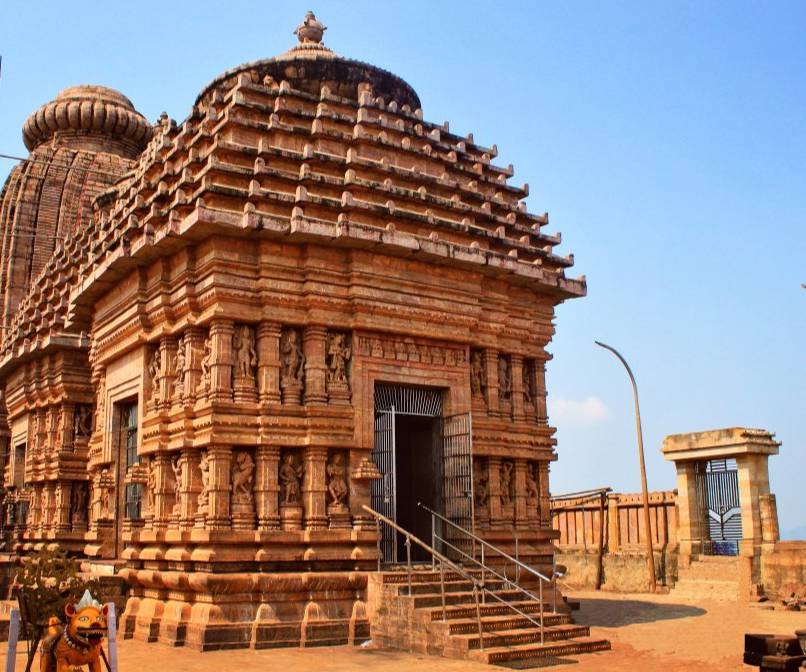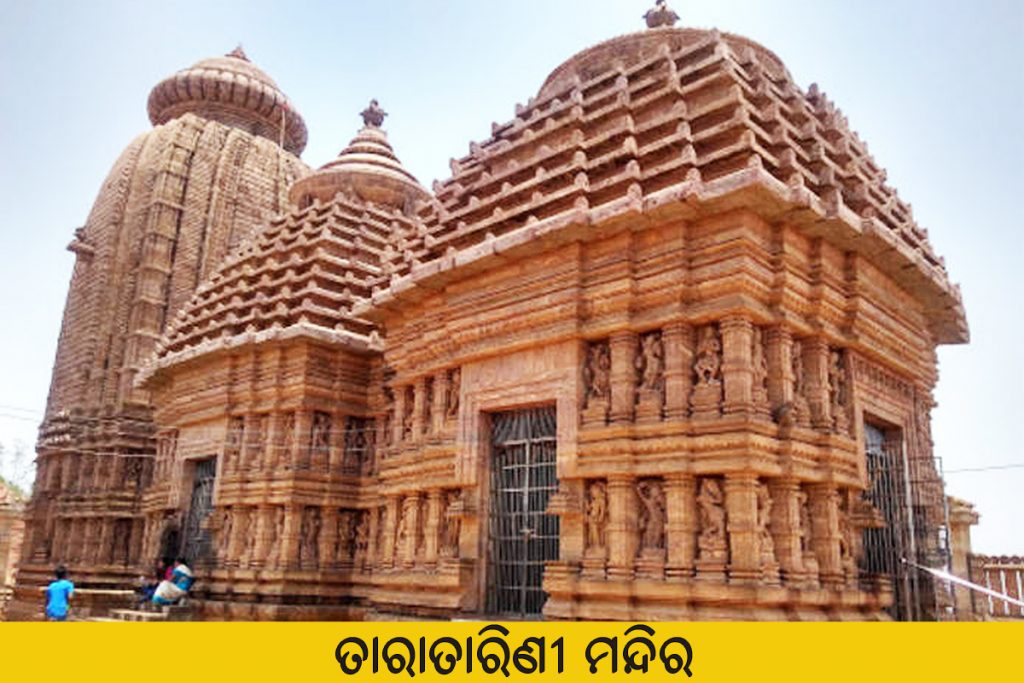
The Taratarini Temple is the Shakti Peetha of the Hindu goddess Taratarini, located in the Ganjam district of Odisha. It is one of the 51 Shakti Peethas in our country. The two sisters are worshiped at the Shakti Peetha as Tara and Tarini. The pedestal is famous for its majesty. Among the various Shakti Peethas in Odisha, Ma Taratarini Peetha has its own uniqueness. The place is famous for Buddhism, Vaishnavism, Tantra and Shakti Peetha.
In the Satya Yuga, Sati, the daughter of a skilled butterfly, married Shiva despite her father’s reluctance. Once the skilled butterfly held a huge sacrifice and invited all the deities to attend. Daksha disliked living in Shiva’s cemetery and wearing bizarre costumes. The daughter-in-law Sati did not invite the talented daughter-in-law to the shrine as she had married Shiva against the will. On hearing of the great organization of his father’s sacrifice from Maharshi Narad, he went to his father’s house and went to the shrine despite Shiva’s prohibition. At the altar, Sati saw her father, a skilled butterfly, and asked if he had invited her. But his father told Sati about Shiva. As a result, Sati could not bear the humiliation of her husband Shiva and sacrificed herself at the altar. Shiva was enraged by the bad news, immediately went to the altar and cut off the head of Daksha and destroyed the altar. Sati’s scorched body was on her shoulders and she went crazy. Knowing that it was impossible to manage creation without Shiva, Lord Vishnu dismantled Sati’s burnt body on Shiva’s shoulders with the Sudarshan Chakra. Sati’s body was found in one place and a single powerhouse was set up in one place. Sati’s breasts fell on Tarini’s back. So two of Tara Tarini’s sisters were created from Sati’s chest.
Maa Tara Tarini is the goddess of Brahmarshi Basishtha. Once upon a time, Basishta appealed to the gods and goddesses to fulfill a wish, but the two goddesses became indifferent. As a result, Brahmarshi became enraged and cursed the two gods. But the goddess calmed down and repented, saying, “In the middle of the Kali Yuga, at the house of my eldest sister Basu Prahraj, on the banks of the Rishikulya river, you will be worshiped and cursed at the top of the Taratarini mountain for a while.” Until then, Maa remained in Lakshmi’s eyes and advised Shiva to bow down.
According to another legend, Sitamata, a captive in the Ashoka forest, wept when she heard the news of the abduction of Mahiravan Ram Laxman during the Tretya period and the sacrifice of her mother Kali. Tears welled up in her eyes, and two goddesses full of various weapons were born, freed from the curse, and expressed their desire to serve Sita. At the behest of Sita, the two goddesses, along with the Hanuman, created the Katyayani and Yoginis from their limbs and killed Mahiravan. Returning from there, Sita also asked her to bid farewell to Matasita, secretly staring at Mahagiri and Taratarini Parbat, the stars of Panchanan and Tumbeshwar, established by Lord Shriram near the ashram of Augusti Muni on the banks of the Rishikulya River. During the reign of Bir Jagannath under Aathgad in Ganjam, Basu Prahraj was a great scholar and tantric in a middle-class family in a small village called Kumari. Despite this, she was childless. So she brought up two daughters and raised them. Basu Prahraj did not neglect the upbringing of the two beautiful girls. One day, the two girls suddenly left the house unnoticed, wearing bangles from a glass on the way, and asked Basu to take their dues from Prahraj. Although Prahraj did a lot of searching, he was disappointed.
A few days later, in a dream, the goddess appeared and described everything. Prahraj had a dream that he was located on the full moon of the two sisters. Basu Prahraj left the bed late that night and, unbeknownst to all, reached the lonely Taratarini mountain. There, two stoneworks are located on the full moon. After realizing the glory of his mother, Basu Prahraj set up two idols and practiced Tantra. He then summoned eminent artisans and began the construction of the temple on the third day of Akshaya as per the rules. The two idols are now known as Tara and Tarini. According to mythology and theology, the Purnagiri mountain was a famous Tantra peetha from ancient times. This green space within the green banana proves to be the backbone of the Tantric instrument, given that it is a perfect place for the Tantric instrument. At present, the temple has stone statues of the goddess Dashmahavidya and sixteen, Bagala, Chhinnamasta, Dhumavati, Matangi, Kamala, Bhubaneswari, Bhairavi and Kali.
Worship of the mother begins in the morning. First, by closing the night, the courtyard is cleansed, the gatekeeper Gangayamuna is bathed and the sun worship begins. Then there is the ritual of bathing the deity, the side deity, and making bells to wake the mother to sleep. The priest pleads to leave the mountain. The door to the temple is opened and the mother’s daily routine is completed. After washing the face, the mother is showered with chua, camphor, vermilion, musk, cow dung, nutmeg, etc. after bathing. Incense sticks. In addition, the five gods are worshiped every morning. Khechudi and Dalma are used as incense for the mother. The doors of the temple are opened to the public after the mangal aalati and wreath-laying. Traditionally, the incense offering is offered to the mother at 12:15 p.m. Once again, the shells are cleaned and the shells are eaten, such as food, pulses, pickles, and fries. After Nirajana’s wreath-laying, the mother falls again. Afternoon incense offerings to saints, saints, guests and worshipers all dine together. This is a very rare practice. At two o’clock in the afternoon, the priest pleads with the mother to leave the mountain, and the mother’s face is washed and dressed. After offering offerings of feet, incense, and lamps, the public is given the opportunity to visit. The evening begins at 5:15 p.m. The temple is cleansed and decorated with baby food. The temple is open until 8:30 pm for the visit of devotees. Then the night incense sticks. In the night incense, shellfish are eaten. After a night out, Maa Pahud is busy. For Pahud BJ, the priest pleads with his mother to be BJP in Paul. There is a custom of reciting hymns. The temple is closed after the hill. The rituals show some special days and some changes to the festivities and pilgrimages. Chandi recitation and Yajna are also performed to the mother on a daily basis. The mother has the ritual of performing all the puja gardens. But Ghartha Yajna is the priest of the temple.
The Taratarini Peetha has been around for about 500 years since the Middle Ages. According to eyewitnesses, a large number of goats were sacrificed to mothers on Tuesdays and Sundays throughout the year in the early twentieth century. More than 10,000 goats and goats were sacrificed, mainly on four Tuesdays of the month of Chaitra. Due to the large number of sacrifices on the hill, the road leading up to it was red with blood. Now the practice has stopped. Now the mother is being offered amish offerings. Pied water is being offered to the mother in a copper pot. Parents are expected to have their first hair shaved on the mother’s back in hopes of having a child, and for the recovery of the sick child, there is a strong crowd here, especially on Tuesdays after the mental fulfillment. You have to go 4 steps to get to the temple. Now there are beautiful roads and ropeways to get to the top of the temple.
Comments
comments
